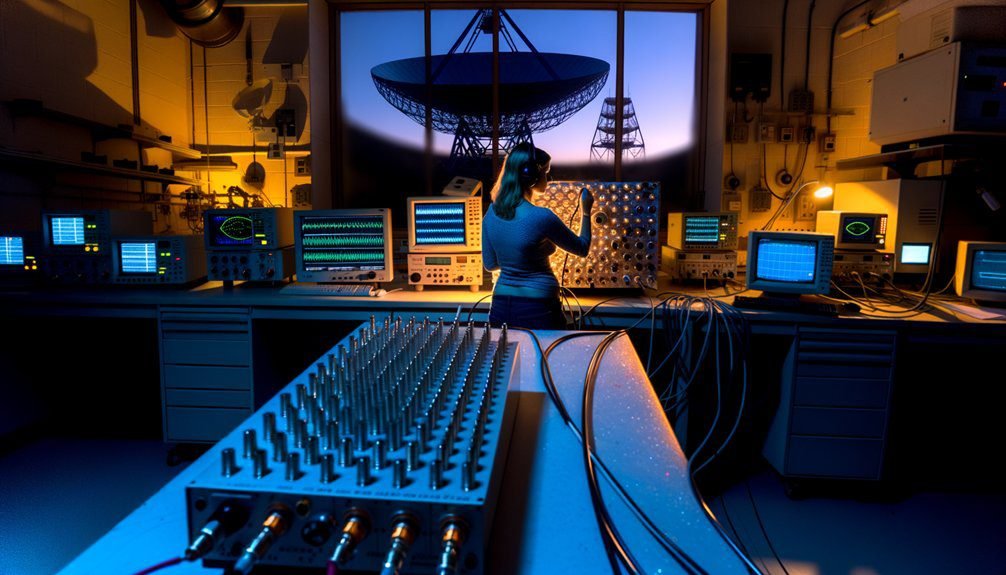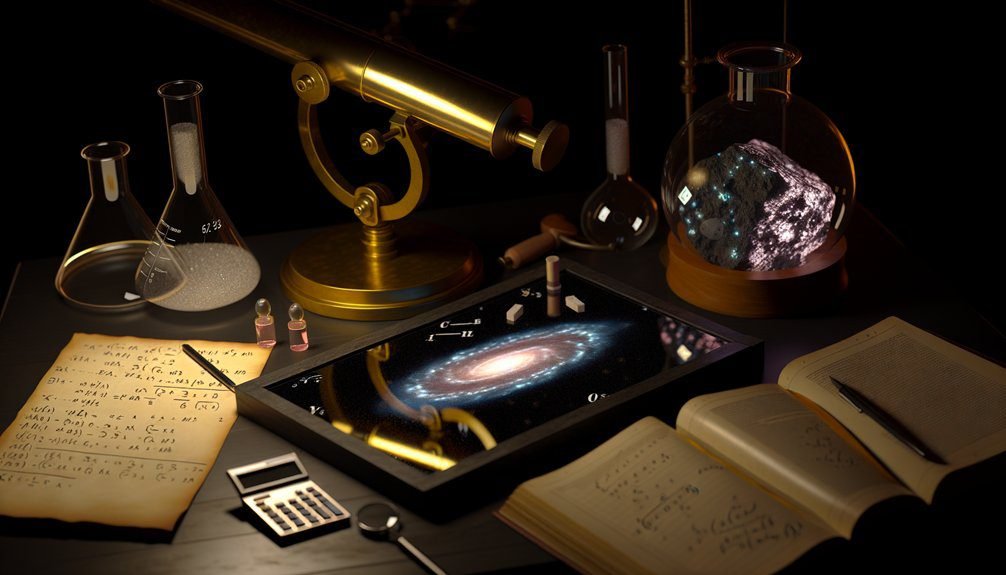You’ve seen three transformative contributions: refined radio search techniques that lower noise, sharpen beams, and detect faint technosignatures; interdisciplinary frameworks that let you link biology, astronomy, and engineering with shared data standards and reproducible methods; and rigorous statistical–philosophical models that quantify life’s prevalence, account for selection effects, and tie probabilities to evidence. Each advance tightens inference and guides observation, and if you keep going you’ll uncover how these approaches reshape priorities and follow-up strategies.
Key Takeaways
- Development of radio search and signal-processing techniques that detect weak extraterrestrial signals and reduce false alarms.
- Interdisciplinary frameworks uniting biology, astronomy, and technology to standardize methods and hypotheses about life.
- Statistical models that quantify life prevalence, selection effects, and uncertainty for credible astrobiological inferences.
- Automated detection and candidate-ranking systems that prioritize follow-up observations and control false-alarm rates.
- Advances in calibration, antenna phasing, and wideband instrumentation that improve localization and spectral coverage.
Development of Radio Search Techniques for Detecting Extraterrestrial Signals

Although the search for extraterrestrial intelligence began with speculative radio experiments, its maturation depended on rigorous signal-processing methods and standardized observational protocols that you can trace across decades. You’ll recognize how matched filtering, Fourier analysis, and time-frequency techniques reduced noise floors and quantified detection significance, making weak narrowband carriers distinguishable from terrestrial interference. You’re guided through calibration practices, antenna array phasing, and beamforming strategies that constrained sky localization and increased survey speed. Statistical frameworks for false-alarm control and automated candidate ranking let you prioritize follow-up resources efficiently. Instrumentation advances—wideband receivers and digital backends—expanded spectral coverage, while telemetry and metadata standards guaranteed reproducibility across observatories. Together these methods converted ad hoc listening into hypothesis-driven experiments evaluating plausibility of extraterrestrial communication signals. By focusing on measurable metrics, cross-validation, and scalable architectures, you’ll see how radio search techniques evolved into a disciplined, interdisciplinary effort that still shapes contemporary astrobiology and cosmology inquiries.
Establishing Interdisciplinary Frameworks Linking Biology, Astronomy, and Technology
When you bridge biology, astronomy, and technology, you create a framework that lets empirical questions about life’s distribution be posed, tested, and iteratively refined across disciplines. You organize shared vocabularies, common data standards, and joint experimental designs so observational astronomy informs laboratory biology and engineering enables scalable instrumentation. Interdisciplinary collaboration becomes procedural: hypothesis formulation, instrument specification, sample analysis, and feedback loops. You assess biological implications of detection thresholds, contamination control, and biosignature validation while keeping astronomical context and technological constraints explicit. The framework prioritizes reproducibility, data provenance, and modular toolchains that let disparate teams contribute incrementally. Governance and training programs align incentives, so methods transfer across fields without losing rigor. Below is a compact mapping you can use to communicate roles clearly.
| Role | Core Task |
|---|---|
| Biologist | Define biosignatures, contamination limits |
| Astronomer | Target selection, observational constraints |
| Technologist | Instrument design, data pipelines |
Advancing Statistical and Philosophical Approaches to the Prevalence of Life in the Universe

If you want credible estimates for how common life is beyond Earth, you need a framework that tightly couples statistical models with clear philosophical priors about what counts as evidence and existence. You’ll combine statistical modeling with conceptual scrutiny so your inferences aren’t just numerically precise but philosophically coherent. Define hypotheses about biosignatures, sampling biases, and model uncertainty; state ontological commitments about life’s minimal criteria; and propagate those choices through Bayesian or frequentist analyses. This interdisciplinary approach helps you assess detection claims, prioritize observations, and quantify confidence.
- Formalize priors and assumptions.
- Quantify observational selection effects.
- Link model outputs to epistemic claims.
You’ll interrogate philosophical implications of probability assignments, clarify how evidence supports existence claims, and design models that transparently reflect conceptual choices. That discipline reduces hidden assumptions, improves interpretability, and advances robust estimates for life’s prevalence.
Frequently Asked Questions
Could Microbial Life Exist in Subsurface Oceans of Icy Moons?
Yes — you could find microbial life in subsurface habitats of icy environments. Energy from hydrothermal vents, redox gradients, and tidal heating can sustain chemotrophic ecosystems independent of sunlight. You’d evaluate geochemistry, fluid dynamics, and microbial ecology to assess habitability, looking for liquid water, nutrient fluxes, and protective ice overburden. Interdisciplinary measurements — spectroscopy, seismology, ocean modeling, and life-detection assays — would test for metabolism, biomass, and biosignatures.
How Do Extremophiles Inform Life-Detection Instruments?
Extremophiles guide how you design life detection instruments by linking extremophile habitats to measurable biosignatures: metabolic gases, isotopic fractionation, preserved organics, and surface pigments. You’ll prioritize sensor suites that detect chemical disequilibria, trace organics, mineral-microbe interactions, and microenvironments (pH, redox, salinity). An interdisciplinary approach—microbiology, geochemistry, engineering—ensures instruments target realistic signals from subsurface, hydrothermal, acidic, or cryogenic niches.
What Ethical Rules Govern Contacting Extraterrestrial Intelligence?
You’d feel like you’re deciding humanity’s fate overnight: contact protocols demand caution, consultation, and transparency. You’ll weigh ethical dilemmas about consent, noninterference, and risk to ecosystems and cultures. You’re expected to follow international guidelines, multidisciplinary review, and staged messaging with broad representation. You’d prioritize planetary protection, minimize harm, and guarantee equitable decision-making. You’ll balance scientific curiosity with moral responsibility, documenting choices and allowing public and expert scrutiny.
Can Life Originate via Non-Dna Chemistries?
Yes — life can plausibly arise via non DNA pathways. You should consider alternative biochemistries like RNA-first, peptide-nucleic acids, or solvent-shifted chemistries (e.g., ammonia, methane). Interdisciplinary evidence from chemistry, planetary science, and systems biology shows self-replication, metabolism-like networks, and compartmentalization don’t require canonical DNA. Evaluating stability, information storage, and catalytic capacity of candidate chemistries helps assess their plausibility on diverse worlds.
How Would Discovery of Alien Life Affect Religion and Society?
You’d probably panic-buy theology books and space-themed bumper stickers, but the faith response would vary: some doubledown, others reinterpret doctrine, and a few secularize beliefs. Societal implications include legal, ethical, and scientific debates reshaping education, policy, and identity. You’ll see interdisciplinary research teams, novel rituals, and political movements lobbying for rights or containment. Overall, institutions adapt unevenly, sparking dialogues about meaning, responsibility, and humanity’s place in a bigger biosphere.